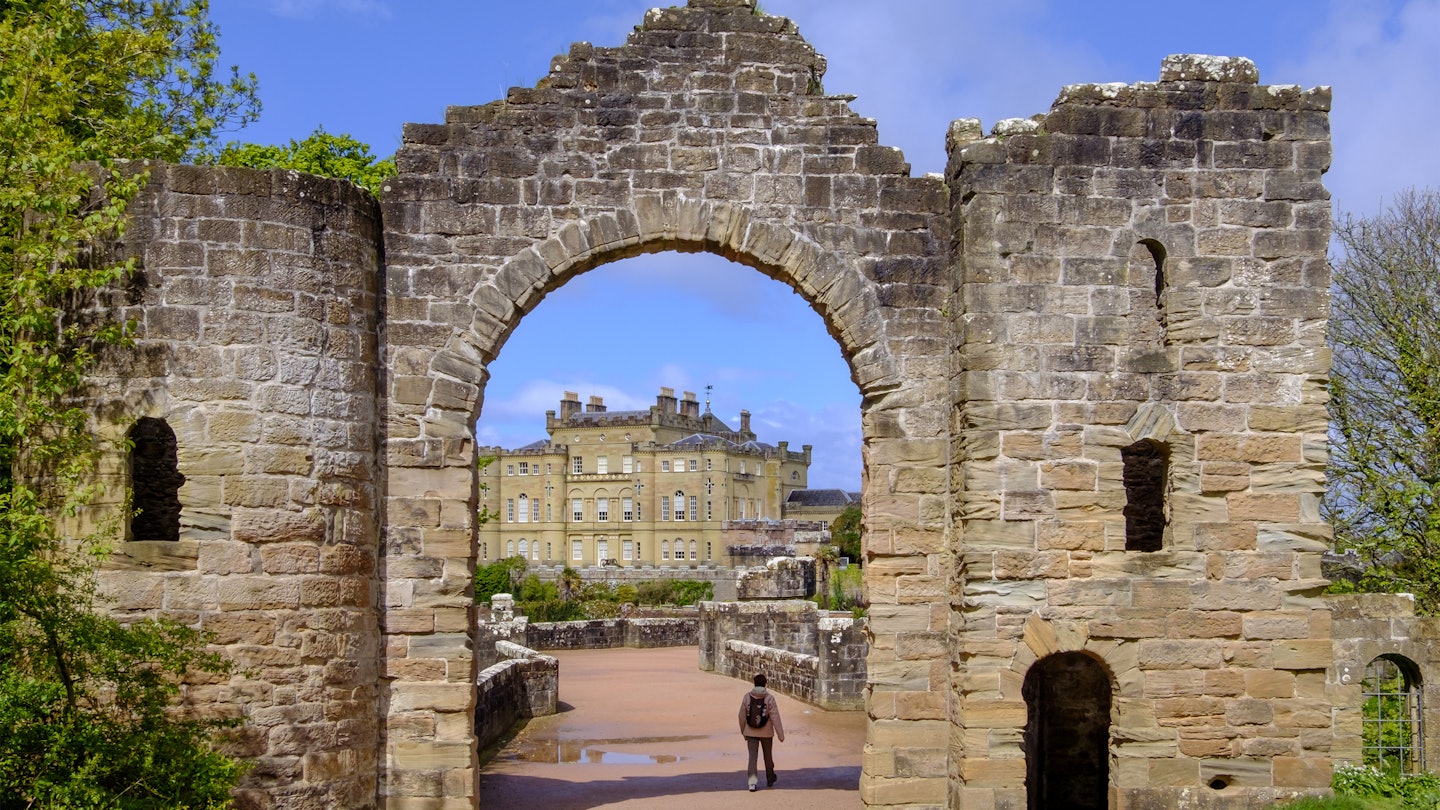

Buildings like Culzean Castle bring the rich history of Scotland to life © Flavio Vallenari / Getty Images
Think of Scotland and you’ll probably think of landscapes. And while its lochs, glens and peaks are indeed impossibly gorgeous, Scotland’s true story lies in what its people have built.
Over the centuries, the Scots have constructed strange tombs in the islands of the north, guarded their territory with epic castles, dreamed up avant-garde public buildings and raised eccentric mansions. And Scotland’s history through architecture isn’t just about the rich: alongside sumptuous aristocratic masterpieces, Glasgow tenements and Edinburgh alleys testify to the ordinary lives lived by Scots past.
Whether you want to spot bagpipe-playing pigs or sleep at a stately home, you can visit every one of these nine buildings that represent the story of Scotland in three dimensions.
Discover Stone Age magic at Maeshowe
Before the pyramids and before Stonehenge, there was Maeshowe, a 4800-year-old tomb on Orkney’s Mainland. Its long passage – perfectly aligned with the sun on the winter solstice – leads into an eerie central chamber decorated with runic Viking graffiti (only a mere 900 years old). At the tomb and nearby sites such as Skara Brae and the Standing Stones of Stenness, the weight of the Stone Age past will fill you with awe, but also startle you with its immediacy. These structures were built by people who lived, laughed, honored their dead and traded across the land and waters that now make up Scotland – a legacy that continues to this day.

Count the sheep (and watch out for the pigs) at Melrose Abbey
The Pictish and Gaelic kingdoms became a united Scotland in the 9th century CE. By the 12th century, King David I was introducing knights, monks and new laws as the country moved into a cutting-edge new era: the late Middle Ages. In 1136, the monks began building Melrose Abbey, which at its peak was an economic as well as a spiritual powerhouse, owning a whopping 15,000 sheep.
But its wealth and Borders location made it vulnerable. It was sacked by the English, rebuilt by Robert the Bruce (whose heart may be buried here), sacked again, then shattered by Oliver Cromwell’s cannons in 1618. The result is an evocative ruin, with much of the abbey’s grand main church remaining. Visitors can examine carvings of dragons and a bagpipe-playing pig, gaze at the fertile Tweed valley and the surrounding hills through long-empty arched windows, and dream of the influence once wielded by the community that occupied this great complex.
Lord it over Scotland at Stirling Castle
We could have chosen Edinburgh’s hulking beauty of a castle or majestic Linlithgow Palace, but for its role in Scotland’s dynastic disputes and bloody wars with the English – not to mention its gorgeous palace interiors – Stirling Castle gets our vote. Its historical importance is summed up by the famous quote, “Hold Stirling and you control Scotland.” A fortress has occupied this site since at least the 12th century; in the 14th century the Battle of Bannockburn was fought outside its walls, and the Stuart monarchs lived here in the 15th and 16th centuries. Today, you can check out rugged ramparts, colorful murals and a vast tapestry showing a unicorn hunt – not to mention views that lord it over Central Scotland.
Get a feel for the 17th century at Real Mary King’s Close
Edinburgh is a city of elegant buildings and buzzing festivals that’s been home to writers, politicians and merchants. But Real Mary King’s Close tells another story. This Old Town alleyway was once packed with families who threw waste out of doors and windows with buckets, and could barely see the sky past the walls and roofs of the medieval city.
On a tour of the Real Mary King’s Close, which was buried when the city was redeveloped in the 18th century, you can start to imagine the smells and other textures of life in the city during this era. You’ll be taken around the now entirely subterranean street by lively guides, who’ll talk you through daily life in the 17th century – not to mention tales of plagues and ghost stories. The experience is a telling reminder that beneath Scottish history’s epic headlines and royal exploits, millions of ordinary people lived and died in often brutal conditions.
Make like Ike in stunning Culzean Castle
By the late 18th century, Scotland was a part of an industrializing Great Britain, and aristocrats turned from fortification to decoration as they fashioned grandiose stately homes like Culzean Castle, designed by Robert Adam in 1792. Set in manicured gardens on an Ayrshire cliff, its solid towers recall the castles of yore, while its interior – with a sweeping oval staircase, opulent salon and soaring colonnades – illustrates the extraordinary wealth of a few fortunate Scots.
But Culzean (“kull-ane”) Castle also shows how power shifts: in 1945 the owners gifted the building to the National Trust for Scotland to avoid inheritance tax, with the apartment at the top designated for Dwight D. Eisenhower in recognition of the role he played in WWII. Their loss is our gain, since today you can not only visit the castle (kids will enjoy the large play area), you can also make like Eisenhower and stay on the top floor.

Climb the soot-blackened spaceship that is the Scott Monument
It’s fair to say that the 1846 Scott Monument, rising 61m (200ft) over Princes Street Gardens in central Edinburgh like a soot-blackened steampunk spaceship, has divided opinion since it was first raised. Charles Dickens dismissed it as “the spire of a Gothic church taken off and stuck in the ground,” and the dust thrown up when its marble blocks were carved gave many of the city’s greatest stonemasons tuberculosis.
Today, you can climb its spiral staircases and platforms to see Edinburgh’s breathtaking architecture, with the jumbled maze of the Old Town on one side and the airier Georgian New Town on the other. The site honors one of Scotland’s greatest storytellers, Sir Walter Scott, who romanticized the land’s past in hugely popular 19th-century novels, and whose opulent 1822 pageant for King George II helped make the tartan the most recognizable symbol of Scottish culture.
Explore the Tenement House, a cozy Glasgow time warp
If Real Mary King’s Close recounts Scottish city life in the 1600s, the cozy time warp of the Tenement House winds the clock forward 300 years. Glasgow’s rise is a big part of Scotland’s history – its population shot from around 80,000 in 1801 to ten times that a century later as trade and industry accelerated.
A shorthand typist named Agnes Toward occupied this tenement flat (a small apartment block) from 1911 to 1965, and today you can visit her home as she lived in it – complete with gas lighting, grandfather clock, coal-fired cooking range, recipes, ornaments and 90-year-old jar of plum jam. A charming evocation of middle-class life, this apartment provides a worthy complement to grander Glasgow monuments like Kelvingrove and the inventive Riverside Museum.
Experience the elegance of art nouveau at Hill House
In the early 20th century, art nouveau pioneer Charles Rennie Mackintosh designed some of Britain’s finest buildings. While his Mackintosh Building at Glasgow School of Art was severely damaged by fire in the 2010s, the Hill House – a 1904 work of timeless elegance designed for a publishing magnate – has had the mirror-image issue, with water damage a chronic problem. Even as scaffolding from ongoing remediation work covers its exterior, it remains an essential Scottish building.
Standing at the top of a hill in Helensburgh, 20 miles (32km) northwest of Glasgow, the edifice comes in the form of a castle or stately home, and it’s filled with sinuous furniture, decorative flourishes and bright light. The result is a fabulous example of Mackintosh’s “Glasgow style” – and a great place to appreciate Scotland’s flair for design and fashion.

Set a course for the future at the Scottish Parliament
In 1998 Scotland got its first parliament in nearly 300 years, with a building to house the newly minted politicians arriving six years later. Conceived as a “flower of democracy rooted in Scottish soil,” the Scottish Parliament Building came in £40 million over budget – and with attendant controversy. Today, the dust has settled, and the building is justly celebrated.
Futuristic yet organic, its buildings are shaped like leaves and branches, featuring a fine debating chamber flooded with natural light and with ponds and pathways tying the building to the gorgeous expanse of nearby Holyrood Park. From the castle, a walk down Edinburgh’s Royal Mile past cobblestones and kirks (churches) to this symbol of modern democracy feels gloriously fitting. Whatever direction Scotland takes next – enthusiasm for independence from the UK is strong – unique buildings like this and the stunning V&A Dundee point to a bright future.
















